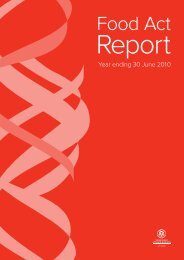Public Health and Communicable Diseases - SA Health - SA.Gov.au
Public Health and Communicable Diseases - SA Health - SA.Gov.au
Public Health and Communicable Diseases - SA Health - SA.Gov.au
Create successful ePaper yourself
Turn your PDF publications into a flip-book with our unique Google optimized e-Paper software.
coverage had dropped by 21% <strong>and</strong> mumps cases were“spreading alarmingly”. 10Anxiety about vaccine safety had emerged long beforethese examples from the past three decades. SinceEdward Jenner developed the cowpox vaccine in 1796,community groups have been expressing their concernsabout the possible effects of vaccination. Figure 1is an etching by famous London social <strong>and</strong> politicalcommentator, James Gillray, circa 1800. It satirises thework of Jenner, showing him vaccinating an anxiouswoman with “vaccine pock hot from ye cow” whilstterrible cow-like growths erupt from the people he hasalready injected. 11Figure 1. “The cow pock – or - wonderful effects ofthe new inoculation,” James Gillray 1802.Vaccination remained controversial throughout the1800s, largely due to inadequate scientific explanationof the method, questionable evidence for its success<strong>and</strong> frequent side effects. Protest marches <strong>and</strong> vigorousresistance followed the introduction of legislation in1853 which declared cowpox vaccination compulsory.At the time, parental fears of the vaccine were mockedby Shieferdecker in his vignette “Dr. C. G. G. Nittinger’sEvils of Vaccination” 12 (Figure 2).Figure 2. “Dr. C. G. G. Nittinger’s Evils of Vaccination,”Christian Charles Schieferdecker 1856.One hundred <strong>and</strong> twenty years later however, thescientific proof <strong>and</strong> evidence of its success (coupledwith an improved vaccine <strong>and</strong> injection technique) weresufficient to finally eradicate smallpox disease from theworld. Unfortunately however, community concernsabout vaccine safety could not be eradicated. Theyhave remained to a greater or lesser extent, fluctuatingbackwards <strong>and</strong> forwards in each country <strong>and</strong> for eachvaccine depending on very specific local circumstances.The current challenge in developed countries is todescribe these circumstances in order to betterunderst<strong>and</strong> why, for example, Australia was affected bythe loss of confidence in DTP vaccine but was largelyunaffected by the Wakefield MMR crisis.Evaluation of vaccine safety in AustraliaLike all pharmaceuticals, no vaccine is 100% safe. Forthis reason all drugs in Australia, including vaccines,undergo strict evaluation before the Therapeutic GoodsAdministration approves licensure <strong>and</strong> supply. 13 Thisevaluation takes place during vaccine development,<strong>and</strong> comprises vaccine trials on a small number ofhealthy children with single vaccines <strong>and</strong> a short periodof follow-up safety assessment. Unfortunately, thisprocess has a limited capacity to identify adverse eventswhich are rare, delayed, occur with specific vaccinecombinations or in a sub-group of children with coexistingdisorders. 14,15Post-licensure surveillance, once vaccines are approved<strong>and</strong> in use, is therefore critical for on-going safetyassessment. Its significance was recently demonstratedin the United States of America where, followingadministration of 12 million doses of oral rotavirusvaccine, a type of bowel disease was detected in somechildren within seven days of receiving the vaccine.Once recognised, the vaccine was promptly withdrawnfrom use globally. 16,17In Australia post-licensure vaccine safety is theresponsibility of the Adverse Drug Reactions AdvisoryCommittee (ADRAC) 18,13 which receives ad hoc reportsof suspected adverse drug reactions. 19 Like all passivesurveillance systems, ADRAC’s main limitation isunderreporting, which compromises the sensitivity ofdetecting significant events 20,21 <strong>and</strong> its ability to reliablymonitor vaccine safety. 2,22 In a study of adverse eventsfollowing BCG vaccination, researchers found theADRAC system only recorded 44% of cases identifiedthrough active surveillance. 23Some local health departments collect <strong>and</strong> reviewreports of Adverse Events Following Immunisation(AEFI), prior to notifying ADRAC. 13 Such is the casein South Australia (<strong>SA</strong>) where, in 1997, vaccine safetysurveillance <strong>and</strong> management was enhanced to includeactive promotion of reporting by parents; feedback<strong>and</strong> advice concerning re-vaccination; <strong>and</strong> referral to aSpecial Immunisation Service for selected children.What do we know about parent attitudes to vaccines<strong>and</strong> safety in <strong>SA</strong>?South Australia now has the highest level ofparental reporting of AEFI worldwide. Parents reportapproximately 63% of all childhood AEFI 24 comparedwith Australia as a whole (3.2%), the U<strong>SA</strong> (7.2%) 26 <strong>and</strong>26
















